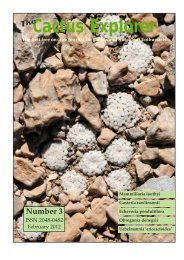Cactus Explorers Journal - The Cactus Explorers Club
Cactus Explorers Journal - The Cactus Explorers Club
Cactus Explorers Journal - The Cactus Explorers Club
Create successful ePaper yourself
Turn your PDF publications into a flip-book with our unique Google optimized e-Paper software.
<strong>The</strong> <strong>Cactus</strong> Explorer ISSN 2048-0482 Number 4 May 2012<br />
Fig.2 John Carr preparing supper.<br />
Fig.3 Rebutia pulvinosa with its small orange flower.<br />
It wasn’t until November 2009 that I made<br />
another attempt at finding these plants. By that<br />
time Google Earth had arrived and it was<br />
relatively easy to plan an alternative route<br />
from Tarija to the Rio Cajas valley. Leaving<br />
Tarija in the early afternoon, John Carr and I<br />
left the main road at Santa Ana and travelled<br />
north through Caldera Grande to Yesera. <strong>The</strong>re<br />
we turned east and drove over the high<br />
mountains through dense cloud to Alto Cajas.<br />
By a series of hairpin bends, the road then<br />
made a rapid descent of around 1000m in<br />
about 4km, taking us down through a band of<br />
forest to the banks of the Rio Cajas (Fig.1,<br />
BLMT769). Fortunately, the river was very dry<br />
so, even though the light was fading, we made<br />
a brief survey of the area before setting up<br />
38<br />
Fig.4 Rebutia flavistyla BLMT769.07.<br />
camp for the night. Very quickly we spotted at<br />
least three species of cacti growing on the<br />
nearby cliffs: a Rebutia, a Parodia and a<br />
Cleistocactus. <strong>The</strong> Rebutia was especially<br />
exciting since it had very small heads, was<br />
offsetting profusely, and was in bud; could this<br />
be R. albiflora? Confirmation would have to<br />
wait until the following morning as it was now<br />
too dark to start climbing the near-vertical<br />
cliffs to take a closer look. We set up camp<br />
under some trees, cooked supper (Fig.2) and<br />
turned in for the night.<br />
After a restless night, during which we were<br />
awoken by a passing truck making deliveries<br />
and by John continually fighting off<br />
mosquitoes (they don’t bother with me if<br />
somebody else is close!), we rose with the sun,<br />
ate breakfast rapidly, collected our cameras<br />
and headed for the cliffs. A short climb<br />
brought us alongside the Rebutia we had<br />
spotted the previous night. <strong>The</strong> bud had now<br />
opened to reveal a small orange flower (Fig.3,<br />
BLMT769.08); it was R. pulvinosa, not R.<br />
albiflora.<br />
Growing with it, and unseen the previous<br />
night, was another quite different Rebutia<br />
(Fig.4, BLMT769.07) and a small Echeveria<br />
(Fig.5, BLMT769.03). <strong>The</strong> second Rebutia grew<br />
as solitary plants with heads 2–3 times the size<br />
of those on the clump of R. pulvinosa.<br />
Superficially, it looked like the ubiquitous R.<br />
fiebrigii, but the spines were shorter, fewer and<br />
all the same glassy-white colour (R. fiebrigii has<br />
short white radial spines and longer, dark<br />
central spines). We decided this second




